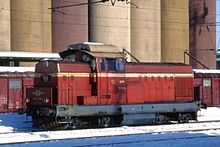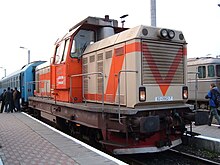CFR series 040 DH
| CFR 040 DH CFR 80/81 BDŽ series 55 |
|
|---|---|
|
Class CFR 80 locomotive
|
|
| Numbering: | CFR 040 DH 001-633 CFR 80/81 0001-0633 BDŽ 55 001-263 |
| Number: | CFR 633 BDZ 263 |
| Manufacturer: | FAUR (license) |
| Year of construction (s): | from 1968-1976 |
| Axis formula : | B'B ' |
| Genre : | LDH 125 |
| Gauge : | 1,435 mm (1,524 mm) |
| Length over buffers: | 12,700 mm |
| Height: | 4,650 mm |
| Trunnion Distance: | 7,200 mm |
| Bogie axle base: | 2,500 mm |
| Total wheelbase: | 9,700 mm |
| Service mass: | 70 t |
| Friction mass: | 70 t |
| Wheel set mass : | 18 t |
| Top speed: | 60 (100) km / h |
| Installed capacity: | 920 kW (1,200 hp) |
| Starting tractive effort: | Max. 225 kN |
| Driving wheel diameter: | 1,000 mm |
| Motor type: | Six-cylinder four-stroke diesel engine |
| Motor type: | Sulzer Type 6 LDA 28 |
| Rated speed: | 750 rpm |
| Power transmission: | hydrodynamic |
| Number of traction motors: | 6th |
| Brake: |
Compressed air brake type Knorr handbrake |
| Train heating: | in places steam heating later electric |
| Particularities: | several variants of the locomotives |
The locomotives of the CFR series 040 DH (factory designation LDH 125 ) are locomotives with hydrodynamic power transmission produced in large numbers for the shunting and light line service on the Romanian state railways CFR . In addition, 475 locomotives were delivered to Romanian industrial companies, 263 to Bulgaria , 42 to industrial companies in the ČSSR , three to Iraq , two to China and one locomotive to the USSR .
history
In order to replace the steam locomotives in heavy shunting and mainline service on branch lines , the CFR procured these locomotives in large numbers. The locomotive is very similar to the SBB Bm 4/4 in the area of the bogies and the sub-area . The entire locomotive was built based on an implementation project at Sulzer AG ; the then Bucharest Lokomotivwerke took over production on 23 August . Production in Bucharest was also made possible because the Romanian locomotive works had licenses for the production of fluid drives. In Germany , this locomotive has become known as one of the first copies made at the Leipzig Fair was issued 1968th Some of the locomotives were equipped with steam heating due to their purpose . These locomotives were later given the designation 80 . The vehicles without train heating were classified as class 81 . After Bulgaria , the locomotives were as BDŽ-55 series delivered.
The locomotives LDH 45 and LDH 70 are similar in structure, but with different engine power and size . Some locomotives of the LDH 125 were also built in broad gauge . Another variant of the LDH 125 was the LDE 125 series , which was built from 1977 onwards with the same design and diesel-electric drive . Of this variant, which required slightly larger superstructures on the same undercarriage to accommodate the more voluminous diesel electrics, 110 copies were made for Romanian industrial companies and a few copies for export to Poland and Brazil . This design can be recognized by the missing sliding platforms on the front sides.
The locomotives were out on marshalling yards and industrial railways used on many routes with medium transport and pitch conditions and replaced where many steam locomotives, especially the CFR-230 series and the CFR-class 50 . They were an epitome in passenger traffic, for example. B. on the Brașov – Zărnești railway line , here with four-part double - decker trains . There have been several changes to the vehicles over the years. Thus, of Remarul 25 vehicles retrofitted with an electric train heating. These machines were given the designation 89 .
Further renovation measures concerned the renewal of the machine system. For example, Alstom offered a conversion variant in which the old Sulzer engines were replaced with new ones with the same hydrodynamic power transmission. The locomotives with the engines from Caterpillar were renamed as class 82 , locomotives with a drive system from MTU were given the designation class 83 . They also received an electric train heating system with an auxiliary diesel engine. As these conversion measures proved their worth, further vehicles were converted at Remarul with the 82 series . A complete redesign of the locomotive appeared again from 2005 at Remarul with the series 84 , in which apart from the renewal of the machinery in the known form, the superstructures were renewed in angular form.
The locomotives that have not been modernized have now been put out to tender in Romania and Bulgaria for sale to third parties.
technical description
The locomotive is equipped with two stems of different lengths and an off-center driver's cab that extends over the entire width of the frame. The units housed in the front end, the diesel engine in the front, the steam heater (now the electric train heater) and the battery in the rear , can be reached from the perimeter. The fluid flow transmission is also housed in the front porch , it extends under the cab floor.
The vehicles are equipped with a conventional pulling and buffing device. The bogies are guided by pivot pins on the frame. The wheel sets are mounted on the roller bearings via guide pins on the bogie. The guide pins are located in two sockets of the axle box. The bogies are cushioned from a combination of coil and leaf springs.
Originally, the six-cylinder four-stroke diesel engine 6 LDA 28 was used as the drive system , producing 920 kW at 750 rpm. The diesel engine had engine charging and charge air cooling. In addition to the usual air filters , it also had an intake silencer. An exhaust silencer reduced the engine noise. The motor drove the fluid transmission , a license type from Voith in St. Pölten, via a flexible coupling . This transmission, which consists of two converters, shifts automatically depending on the engine speed and speed. Downstream of the fluid flow transmission was a secondary transmission for speeds of 60 km / h in the shunting gear and 100 km / h in the route gear. The reversing gear was flanged after the gearbox . The inner wheel sets of the bogies were driven via cardan shafts, the outer wheel sets with through drives.
The alternator or battery supplied the on-board network of the locomotive, which had a voltage of 110 V. The cooling unit was attached to the front of the large porch; it had 8 cooling elements on each side. A hydrostatically driven fan wheel ensured that the cooling water was recooled. The engine lubricating oil and the gear oil were recooled using heat exchangers . Originally, the locomotives for passenger train service were equipped with an oil-fired boiler, later with an electric heating generator. The locomotives for the shunting service had ballast at this point.
Individual evidence
- ↑ a b c d e f g Internet site about the LDH-125 series
- ↑ Wolfgang Glatte, Lothar Reinhardt Diesel Locomotive Archive, Transpress-Verlag Berlin, 1970, page 182
- ↑ Description of the locomotives used in Bulgaria
- ↑ Internet report about the sale of LDH 125 locomotives at the CFR
- ↑ List of class 55 locomotives advertised for sale at the BDZ
literature
- Wolfgang Glatte, Lothar Reinhardt Diesel Locomotive Archive, Transpress-Verlag Berlin, 1970



